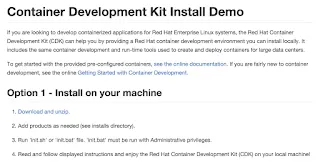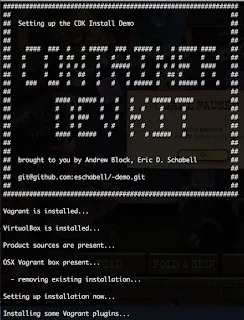The original post, created by Eric D. Schabell can be found here: How to install Red Hat Container Development Kit (CDK) in minutes
As an application developer or architect tasked with exploring the possibilities that containerized applications offer, there is little help with getting all the tools together to get you started.
Until now.
Red Hat provides a Container Development Kit (CDK) that has all the tooling you need for your local OSX, Linux or Windows environment. It also has a few containers pre-configured for you to explore.
Since the announcement of the Red Hat CDK 2 beta a few months ago, we thought it was time to take a closer look and that resulted in creating an automated installation project called the Container Development Kit Install Demo.
What you get
First off, the Red Hat CDK is a product that is available to customers and partners, for more details on who has access and how to obtain access, see Red Hat Developers. Also for the details around what specifications for your machine, see the online documentation.
The Red Hat CDK is packaged into a RHEL 7 virtual machine that you can start on your machine after installing this project. There are several choices provided with pre-configured installations, but they all include the basic setup for Docker and the tools needed to start leveraging Docker based containers.
The following containers can be started after installing this project for you to start exploring:
- OpenShift Enterprise - a containerized version of OpenShift Enterprise can be started that can be accesses through a Web console in your browser or via the OpenShift command line tools. Explore your very own private PaaS developer experience with this container.
- Kubernetes - a container to set you up for exploring a Kubernetes cluster. It is setup to run as an all-in-one Kubernetes master to manage pods and node for running multiple pods.
- Eclipse - a container setup for you to use the Eclipse IDE with a Linux Tools/Docker Tooling plug-in allowing developers to manage containers directly from their development environment.
On top of this you can start creating your own container based applications after you are comfortable with how these examples work.
Container development
As you might not want to go through all the steps in the installation guide time and again to setup the Red Hat CDK on your machine, here I hope to make it so simple anyone can do it.
Not only that, you can do it in just four steps, I promise!
It is really that easy with the fully automated Container Development Kit Install Demo project put together to make the process both fool proof and repeatable. So what are the three steps you ask?
- Download and unzip CDK install demo.
- Add products as needed.
- Run 'init.sh' or 'init.bat' file.
- Read and follow displayed instructions and enjoy the Red Hat Container Development Kit (CDK) on your local machine!
It will check if you have the pre-requisites installed, but if you don't and start the installation it will stop, warn you and provide the links to go and get what is missing. The same goes for the products needed, which depend on your OS for the correct virtual image you need to run the Red Hat CDK, don't worry, it will point you in the right direction if you read the output.
For more information around containers, a Cloud stack and why you need to care about this containerized stack for your application development, see the App Dev Cloud Stack series that takes you on a tour of the Red Hat Cloud Suite.
We will be back soon to dive deeper into how these container examples in the Red Hat CDK look and how to get started with them.
The Author
Eric D. Schabell is a Red Hat Technology Evangelist.
You can visit Eric's blog here. He has created a multitude of demos that cover interesting aspects of Red Hat's technologies and offers.
You can also follow Eric's twitter account: @ericschabell
Sull'autore
Ricerca per canale
Automazione
Novità sull'automazione IT di tecnologie, team e ambienti
Intelligenza artificiale
Aggiornamenti sulle piattaforme che consentono alle aziende di eseguire carichi di lavoro IA ovunque
Hybrid cloud open source
Scopri come affrontare il futuro in modo più agile grazie al cloud ibrido
Sicurezza
Le ultime novità sulle nostre soluzioni per ridurre i rischi nelle tecnologie e negli ambienti
Edge computing
Aggiornamenti sulle piattaforme che semplificano l'operatività edge
Infrastruttura
Le ultime novità sulla piattaforma Linux aziendale leader a livello mondiale
Applicazioni
Approfondimenti sulle nostre soluzioni alle sfide applicative più difficili
Serie originali
Raccontiamo le interessanti storie di leader e creatori di tecnologie pensate per le aziende
Prodotti
- Red Hat Enterprise Linux
- Red Hat OpenShift
- Red Hat Ansible Automation Platform
- Servizi cloud
- Scopri tutti i prodotti
Strumenti
- Formazione e certificazioni
- Il mio account
- Supporto clienti
- Risorse per sviluppatori
- Trova un partner
- Red Hat Ecosystem Catalog
- Calcola il valore delle soluzioni Red Hat
- Documentazione
Prova, acquista, vendi
Comunica
- Contatta l'ufficio vendite
- Contatta l'assistenza clienti
- Contatta un esperto della formazione
- Social media
Informazioni su Red Hat
Red Hat è leader mondiale nella fornitura di soluzioni open source per le aziende, tra cui Linux, Kubernetes, container e soluzioni cloud. Le nostre soluzioni open source, rese sicure per un uso aziendale, consentono di operare su più piattaforme e ambienti, dal datacenter centrale all'edge della rete.
Seleziona la tua lingua
Red Hat legal and privacy links
- Informazioni su Red Hat
- Opportunità di lavoro
- Eventi
- Sedi
- Contattaci
- Blog di Red Hat
- Diversità, equità e inclusione
- Cool Stuff Store
- Red Hat Summit




